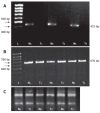Identification of squamous cell carcinoma associated proteins by proteomics and loss of beta tropomyosin expression in esophageal cancer
- PMID: 17131471
- PMCID: PMC4087770
- DOI: 10.3748/wjg.v12.i44.7104
Identification of squamous cell carcinoma associated proteins by proteomics and loss of beta tropomyosin expression in esophageal cancer
Abstract
Aim: To assess the proteome of normal versus tumor tissue in squamous cell carcinoma of the esophagus (SCCE) in Iranian patients and compare our results with former reports by using proteomics.
Methods: Protein was extracted from normal and tumor tissues. Two dimensional electrophoresis was carried out and spots with differential expression were identified with mass spectrometry. RNA extraction and RT-PCR along with immunodetection were performed.
Results: Fourteen proteins were found whose expression levels differed in tumor compared to normal tissues. Mass spectrometric analysis resulted in the identification of beta-tropomyosin (TMbeta), myosin light chain 2 (and its isoform), myosin regulatory light chain 2, peroxyredoxin 2, annexin I and an unknown polypeptide as the down regulated polypeptides in tumor tissue. Heat shock protein 70 (HSP70), TPM4-ALK fusion oncoprotein 2, myosin light polypeptide 6, keratin I, GH16431p and calreticulin were the up-regulated polypeptides found in tumor tissue. Several of these proteins, such as TMbeta, HSP70, annexin I, calreticulin, TPM4-ALK and isoforms of myosins, have been well recognized in tumorigenesis of esophageal or other types of cancers.
Conclusion: Our study not only supports the involvement of some of the formerly reported proteins in SCCE but also introduces additional proteins found to be lost in SCCE, including TMbeta.
Figures



Similar articles
-
Proteomic profiling of proteins dysregulted in Chinese esophageal squamous cell carcinoma.J Mol Med (Berl). 2007 Aug;85(8):863-75. doi: 10.1007/s00109-007-0159-4. Epub 2007 Feb 22. J Mol Med (Berl). 2007. PMID: 17318615
-
Using proteomic approach to identify tumor-associated proteins as biomarkers in human esophageal squamous cell carcinoma.J Proteome Res. 2011 Jun 3;10(6):2863-72. doi: 10.1021/pr200141c. Epub 2011 May 3. J Proteome Res. 2011. PMID: 21517111 Free PMC article.
-
Two-dimensional gel analysis of protein expression profile in squamous cervical cancer patients.Gynecol Oncol. 2005 Oct;99(1):26-35. doi: 10.1016/j.ygyno.2005.05.041. Gynecol Oncol. 2005. PMID: 16051329
-
Proteomic analysis indicates the importance of TPM3 in esophageal squamous cell carcinoma invasion and metastasis.Mol Med Rep. 2017 Mar;15(3):1236-1242. doi: 10.3892/mmr.2017.6145. Epub 2017 Jan 25. Mol Med Rep. 2017. PMID: 28138712 Free PMC article.
-
Differential proteomics mass spectrometry of melanosis coli.Am J Transl Res. 2020 Jul 15;12(7):3133-3148. eCollection 2020. Am J Transl Res. 2020. PMID: 32774690 Free PMC article. Review.
Cited by
-
Novel ALK inhibitors in clinical use and development.J Hematol Oncol. 2015 Feb 27;8:17. doi: 10.1186/s13045-015-0122-8. J Hematol Oncol. 2015. PMID: 25888090 Free PMC article. Review.
-
Novel adaptor protein Shf interacts with ALK receptor and negatively regulates its downstream signals in neuroblastoma.Cancer Sci. 2013 May;104(5):563-72. doi: 10.1111/cas.12115. Epub 2013 Mar 13. Cancer Sci. 2013. PMID: 23360421 Free PMC article.
-
Tyrosine kinase gene rearrangements in epithelial malignancies.Nat Rev Cancer. 2013 Nov;13(11):772-87. doi: 10.1038/nrc3612. Epub 2013 Oct 17. Nat Rev Cancer. 2013. PMID: 24132104 Free PMC article. Review.
-
Quantitative tissue proteomics of esophageal squamous cell carcinoma for novel biomarker discovery.Cancer Biol Ther. 2011 Sep 15;12(6):510-22. doi: 10.4161/cbt.12.6.16833. Epub 2011 Sep 15. Cancer Biol Ther. 2011. PMID: 21743296 Free PMC article.
-
Identification of ALK as a major familial neuroblastoma predisposition gene.Nature. 2008 Oct 16;455(7215):930-5. doi: 10.1038/nature07261. Epub 2008 Aug 24. Nature. 2008. PMID: 18724359 Free PMC article.
References
-
- Gray JW, Collins C. Genome changes and gene expression in human solid tumors. Carcinogenesis. 2000;21:443–452. - PubMed
-
- Vogelstein B, Fearon ER, Hamilton SR, Kern SE, Preisinger AC, Leppert M, Nakamura Y, White R, Smits AM, Bos JL. Genetic alterations during colorectal-tumor development. N Engl J Med. 1988;319:525–532. - PubMed
-
- Hondermarck H, Vercoutter-Edouart AS, Révillion F, Lemoine J, el-Yazidi-Belkoura I, Nurcombe V, Peyrat JP. Proteomics of breast cancer for marker discovery and signal pathway profiling. Proteomics. 2001;1:1216–1232. - PubMed
-
- Kim W, Oe Lim S, Kim JS, Ryu YH, Byeon JY, Kim HJ, Kim YI, Heo JS, Park YM, Jung G. Comparison of proteome between hepatitis B virus- and hepatitis C virus-associated hepatocellular carcinoma. Clin Cancer Res. 2003;9:5493–5500. - PubMed
-
- Anderson NG, Matheson A, Anderson NL. Back to the future: the human protein index (HPI) and the agenda for post-proteomic biology. Proteomics. 2001;1:3–12. - PubMed
Publication types
MeSH terms
Substances
LinkOut - more resources
Full Text Sources
Other Literature Sources
Medical
Research Materials
Miscellaneous

